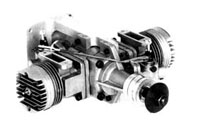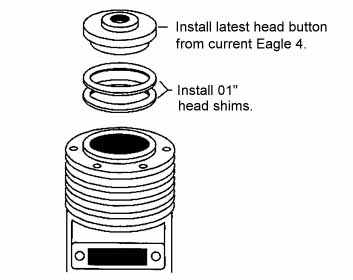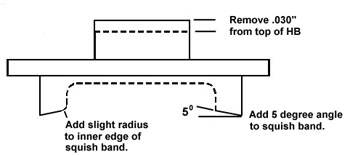

 |

|
|

Project #8 - Taming the 1.20 Twin

|
 User Manual User Manual
Utilizing cylinder assemblies
from the Eagle II .60, the 1.20 twin was introduced in the late
70's with production continuing into the early 80's. Early models
were equipped with the ancient 2-jet carburetor while those produced
from 1980 and on used the newer MKX series carbs. These engines
were known to be finicky to adjust and run hot, with a tendency
for a cylinder to flameout during throttle transitions. This
should not be too surprising since the Eagle II .60, upon which
the 1.20 is based, exhibited the same problems, so with the 1.20
the problems are double! Fortunately, the 1.20 responds just
as well to the same modifications that we have used to tame the
.60. |
So, what's the problem?
The Eagle .60 II was
produced at the beginning of an era during which Duke was obsessed
with making his engines perform well on FAI (no nitro) fuel.
This resulted in unusual head button designs with very small
combustion chambers, wide squish bands, and high compression.
While Duke did manage to get good power from his engines on FAI
fuel, this often came at the expense of poor running qualities
when using the typical 10-15% nitro fuel that most modelers preferred
to use. Engines were finicky to adjust, ran hot, and would often
flameout during throttle transitions. So, naturally, the 1.20,
being two Eagle .60's, exhibited the same problems. Having two
two carburetors to setup, particularly the older 2-jet types,
certainly didn't make running the 1.20 any easier either.
|
|
The Fix
The first
step is to obtain the parts you will need. An absolute must is
to order two new Eagle IV series head buttons, along with four
0.01" shims from Fox Mfg. Don't even bother messing with
the engine without these! If your engine has the earlier
2-jet type carburetors, upgrading these to the MKX series, NOT
the EZ series, is highly recommended. The ancient 2-jet
carb. is difficult enough to operate when there is only one to
worry about.
Install the head
head buttons and shims as shown in the diagram below: |
Installing Head Button
and Shims

 |
While the basic
head button fix is generally acceptable, if you have the capability
to do a bit of simple machining, the Eagle IV head button can
be improved further. By lowering the position of the glow plug
by .030" and adding a 5 degree angle, and a slight radius,
to the squish band, you can achieve an even smoother running
engine. The diagram below shows the details. The squish band
angle is not ultra-critical, and the radius can be easily achieved
by wrapping some #400 sandpaper around a small dowel, and working
the inner edge while spinning it up in a lathe. Don't get too
carried away, just round off the sharp edge a bit. Again, not
really critical. The shims mentioned above are still required. |
Head Button Modification
 |
|
Adjusting the Carburetors
With the new head buttons and MKX series carbs. installed, the
engine is now at least capable of proper operation. All that
remains is the challenge of properly adjusting the carburetors.
First, you should understand that both cylinders share
both carburetors. They are not exclusive! This means there will
be considerable interaction between the carburetors during the
adjustment procedure. It is possible to have good top end power
with one carb set very rich and the other very lean. However,
the idle and mid-range will be terrible. Getting the settings
properly synchronized is the tough part. What we did was remove
the carbs. and install them individually on an Eagle .60 where
they were adjusted for similar operating characteristics. Then
they were re-installed on the 1.20 and adjusted together, one
click at a time until proper settings were achieved. Try to think
of the the carbs. as being one large carburetor rather than individual
carburetors for each cylinder.When you make an adjustment to
one, make the same adjustment to the other. Of course, it helps
when both carbs. are pre-set to about the same settings. If you
don't have an Eagle .60 on which to adjust the carbs. separately,
then pre-set the needle valves as described in our section on
MKX carburetors and start from there.
This is a procedure that requires a lot of patience, but hang
in there and you'll find that proper operation is achievable.
When properly adjusted, the 1.20
will start easily on one cylinder, then a touch of the glow clip
will fire up the other. Since the cylinders fire together, the
engine is also very smooth with little vibration, and tends to
sound more like a large single than a twin.
Propeller Note
Unlike 4-stroke or gas engines, the 1.20 is not happy swinging
large propellers. If lugged down much below 10,000 rpm it will
quickly overheat. Note the following quote from the owners
manual:
"In selecting your propeller
remember that the Fox Twin is a high speed machine designed to
run in the 11,000 to 14,000 RPM range.. ...In practice, an 11-8
is about as small as practical and a 16-4 is about as large as
practical. Leave the huge propellers for motors that are incapable
of revving up". |
|